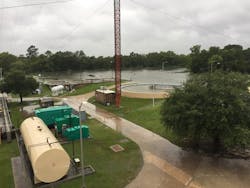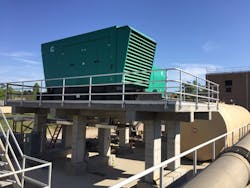About the author:
Paul Wood, P.E. is a lead process engineer at Lockwood, Andrews & Newnam Inc. He can be reached at [email protected].
Greg Hall Jr. is used to riding out storms. He has done it many times in his 15 years as superintendent of the city of Conroe, Texas’ wastewater treatment plant, often staying on site for anywhere from four to six days at a time. He did so during the “Tax-Day Flood” in 2016 and did not have any reason to suspect anything would be different during Hurricane Harvey. So on Aug. 25, 2017, Hall was prepared to ride it out. He and his crew stocked up on supplies and settled in. What was not immediately apparent, however, was the magnitude of the storm and the resulting damage to the plant.
The plant itself is located in a berm 100 yards from the San Jacinto River. A 10-ft levee surrounds the plant, which has the capacity to treat 12 million gal of wastewater daily and is the sole plant currently serving the city of Conroe–a community north of Houston comprised of more than 82,000 people. Conroe also was the fastest-growing city in America in 2017, according to the U.S. Census Bureau. Originally built in 1972, the plant is a conventional activated sludge plant that was expanded and rehabilitated two years ago by Lockwood, Andrews and Newnam Inc. (LAN), a planning, engineering and program management firm based in Houston.
“It was a $14 million effort to keep up with the city’s growth and really just get [our technology] into the 21st century,” Hall said.
Dealing With Disaster
Harvey made landfall late at night on Aug. 25 and lashed the city for almost three days, causing extensive flooding and damage in much of its path. The Lake Conroe watershed’s water levels peaked at 206.2 ft above average sea level during the storm, according to the San Jacinto River Authority (SJRA). The watershed received roughly 972,000 gal of water, or about 130,000 cu ft of water per second. In order to avoid a dam breach, SJRA released water into the San Jacinto River.
Water was released from Lake Conroe at a rate of roughly 79,000 cu ft of water per second—equal to the amount of water in an Olympic-sized swimming pool released every 1.1 seconds. Homes and businesses along the San Jacinto River suffered the most damage as the river was overwhelmed with water.
By 3:30 a.m. Aug. 29, Hall made the decision to evacuate everyone but the essential crew members–seven out of the 11 staff members initially prepared to stay the duration of the storm. By this point, the access road to the plant was completely flooded, so the crew was evacuated by rescue boat by the Conroe Fire Department. Surrounding subdivisions already had faced mandatory or recommended evacuations. Six hours later, the water in the San Jacinto River overtopped the plant levee by a foot.
Around 9 a.m. on the same day, Hall was evacuated. By this time, the plant was under so much water that he and the remaining crew had to be evacuated by helicopter.
“I was in shock. I couldn’t imagine the plant ever being flooded like that … It was an unreal feeling,” Hall said. “Some equipment just completely unmoored and floated away. It was a mess.”
Most of the 11 buildings on site had at least 6 ft of water in them; the operations building was completely underwater. During the few days when the plant was totally inoperable, the 5 million gal per day of untreated wastewater on average that passed through the plant passed without treatment, flowing directly into the San Jacinto River. There also was significant damage to the electrical service equipment and much of the mechanical processing equipment.
“There was very little that wasn’t damaged,” Hall said. As soon as the floodwaters receded enough for them to do so, the crew, along with other city staff, moved in.
“Sewer sludge was everywhere … it took two days of just washing things down before we could actually do anything,” Hall recounted. “The city staff put an amazing amount of effort to get the plant up and running just five days after Harvey.”
Rapid Recovery
By some miracle, a few storm water pumps were still workable.
“We were able to send out our pumps to Lufkin Armature, and they worked through the weekend to flush them out, rotate them and get them back up and running,” he said.
David Hayes, vice president of Wharton-Smith Inc., the general contractor for the recovery, described the city’s efforts as “remarkable.”
“The crew members were literally working out of pickup trucks and trailers,” he said. “They took it upon themselves to bring the plant back in operation, which they did by the evening of Sept. 2—just days after the entire system shut down.”
In the long term, recovery has not been without its challenges. One of the first concerns was whether to—and how to—raise the electrical equipment and generators.
“Do we leave it where it is and run the risk of going through this again, or do we try to raise it?” Hall said he remembers thinking. “It’s a daunting task.” Eventually, the plant’s superintendent and Wharton-Smith decided to raise
the equipment. Hayes agreed that it was a challenge.
“You’re trying to raise up generators, electrical switch gear, the primary transformer … which is 18,000 lb. All those pieces are moving up 11 to 13 ft in the air. Where is it going to be placed?” he said.
Beyond that, Conroe also is looking to elevate the plant’s generators and other equipment at its three operations buildings. Because of their previous experience with the plant, Wharton-Smith tapped LAN to work as project engineers and on mitigation. The city of Conroe continues to work with the Texas Municipal League, Wharton-Smith and LAN on Federal Emergency Management Agency mitigation efforts. It is possible that the berm that surrounds the plant will be raised above its 10-ft height to better protect the plant as part of the long-term recovery efforts. During Harvey, the berm was breached by at least 2 ft. The city has been “very proactive” on mitigation efforts, Hayes said.
Finding suppliers for much of the equipment that needed to be repaired or replaced was another challenge.
“The sheer magnitude of Harvey caused a resource vacuum in Houston. There’s only so many resources in a certain region, and they’re being consumed very fast,” Hayes said.
Thanks to the city’s efforts, much of the equipment that needed to be replaced was ordered early on in the process, he added.
“Our public works staff care about their plant and about the environment, and they’re very good at their jobs. They know the plant inside and out,” Hayes said. “There are plants that are still not operational after Harvey.”
“I don’t think anyone could have truly been prepared for Harvey,” Hall said. “But if this were to happen again, the most important thing to keep in mind is to know your limitations and trust that your crew will make good decisions.”
Ongoing Efforts
Wharton-Smith and LAN expect the plant to be fully operational by this fall.
“Every day is a little victory,” Hall said. “For example, we’ve been running on generator power since Sepy. 1, which is very expensive, and in February we just got utility power for the first time.”
The moral of the story, he said, is that the plant was not ready for a 500-year flood.
“We’ve survived all the other floods before this. I’m hoping that now we’ll be better equipped for this kind of event if it happens again.”


